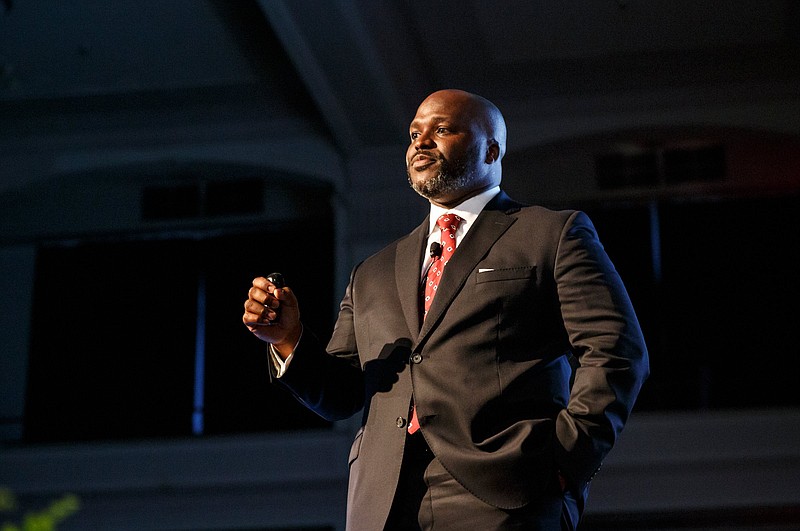By December, according to a timetable laid out in July by the Hamilton County Department of Education, a 10-year master plan for new, merged and renovated schools was to be presented to the public for final recommendations.
In between were to be meetings with stakeholders, community forums and opportunities to refine the plan. If meetings with stakeholders have been held, they were not broadcast widely. And the community forums only began last night. The timetable, undoubtedly, is behind.
That's not bad in itself if the public knows what is going on in relation to the potential $1 billion plan. After all, we should all want a project that could involve as many as 58 schools to be scrutinized from every conceivable angle before being settled upon.
Measure twice, cut once. Isn't that the carpenter's mantra?
But the plan has been little discussed publicly since July. Have changes already been made? If so, who made them and why weren't they made in public?
And the community forums are coming at a time of year when everybody has a thousand other things going on. Now that the plan is already behind, would it have hurt to push the meetings to January and February when the holidays are behind us and weather coaxes more people to be inside?
Yet, these meetings could be the most critical opportunity for public debate before final plans are drawn up. Oh, we're sure there will a time down the road when more comments can be made. But that time may be too late to make any substantial changes.
We remember October 2017 when the district revealed a $125 million plan for schools. Superintendent Dr. Bryan Johnson had held community meetings before the plan was released, but attendees said the meetings seemed little more than preliminary talks. When the plan was released, they were flabbergasted.
This plan is much broader than the 2017 proposal. It would close 15 schools, renovate 11, build additions to 10, repurpose nine, relocate seven programs, replace (and rebuild) three schools and build three new ones.
It's a lot to swallow even if the goals of operating a more cost-efficient system, better utilizing the capacity available, and making all schools safer and better ready to educate students are good ones.
Remaining Community Forums
— Wednesday, 5:30-7:30 p.m., Lookout Valley Middle/High School— Thursday, 5:30-7:30 p.m., Dalewood Middle School— Thursday, 6-8 p.m., East Brainerd Elementary School
We said in July the biggest drawback to what appears to be a thorough and excellent plan is emotion. For elementary school students, a new or renovated school may seem like an adventure. For high school students, it may seem more like the ripping apart of their lives.
And this plan moves, replaces or closes seven high schools, including Brainerd, Center for Creative Arts, Chattanooga School for the Arts and Sciences, Harrison Bay Vocational High School (Hamilton County High School), Sequoyah Vocational High School, Tyner and Washington Alternative School.
Some of these schools, though, are currently used at 26%, 55%, 62%, 66% and 69%. If as taxpayers we expect our money to be used efficiently and to the best use for the widest number of people, we should expect better. And that's what this plan offers.
However, we have no expectations this plan can be implemented at one time and with no changes. So it's important for the public to attend these community forums and make their feelings known. In the end, some who are vocal may get their way if alternatives can be found, but many will not.
According to plan submitted by the Florida-based MGT Consulting Group, the 10-year cost of repairing and maintaining the district's 74 schools without any changes is $1.36 billion. By making the changes suggested, the district's 10-year cost would be $855 million.
The average school capacity would rise from 695 during the 2018-2019 year to 856, closer to the district-preferred number of 1,000. But questions remain.
Will the changes, especially at district high schools, promote or detract from the community schools model the system was promoting in early 2018? Will the district's Opportunity Zone, created to prevent state management of low-performing schools, shrink, be redrawn or be eliminated? Will racial and socioeconomic desegregation, said to be the goal for the district by the NAACP in early 2018, be achieved by the changes or worsen from the changes?
And there is this: Last spring, the school board sought and failed to get a 34-cent property tax increase to add teachers, staff members and programs to the current incarnation of district schools. If the district were to implement some of the cost-savings proposals in the master plan, would that also lessen the need for more teachers and staff members?
The public has every right to hear the answers to these questions and others from school officials and school board members. It deserves to know if changes already have been made to the plan. And the public should know what changes are already set in stone and which ones are more malleable.
